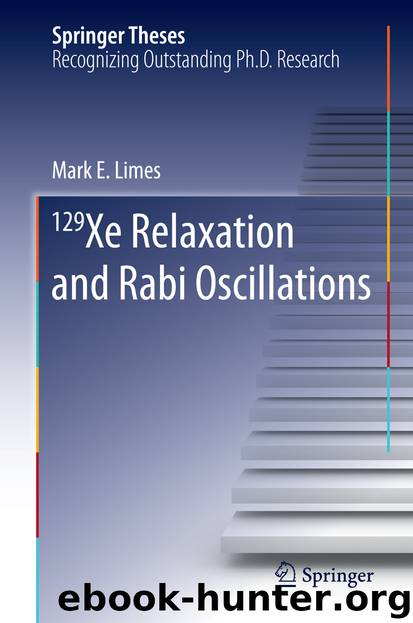129 Xe Relaxation and Rabi Oscillations by Mark E. Limes

Author:Mark E. Limes
Language: eng
Format: epub
Publisher: Springer International Publishing, Cham
2.6 Summary
The solid 129Xe data presented herein are the most reproducible to date. Though much work remains to understand this problem, the work contained in this thesis again opens the field of solid 129Xe longitudinal relaxation for further study. The findings seem to indicate that spin-rotation mediated by Raman scattering of harmonic phonons is not sufficient to describe the observed relaxation in solid ice 129Xe. In summary, the 129Xe show a structure-dependent T 1 time, characterized by snow and ice. The ice data give T 1 times that are roughly 30 % longer than the previously accepted spin-rotation mediated by two-phonon Raman scattering theory, over a temperature range of 77–150 K. The T 1 data at 77 K also show a fundamental difference between ice and bulk snow, supported by oxygen-introduction experiments on snow that indicate the surface of the snow crystallites relax faster than bulk snow. Temperature-dependent snow experiments show increasing relaxation rates with experimental run time, and this phenomenon is not well understood. Adjusting the isotopic concentration in the xenon solid demonstrates no isotope dependence on relaxation rates, confirming previous results and excluding a class of mechanisms responsible for relaxation. Delving into the theory of the nuclear spin relaxation due to interference with a phonon bath, the groundwork is laid for calculation of spin-rotation mediated by higher order and more exotic phonon mechanics, including anharmonic phonon behavior.
This leaves room for much future work, including a lower temperature range dependent T 1 study (4 K–50 K) on ice and snow in order to better determine T 1 structural dependence. Snow, in particular, leaves many questions to be answered, some of which can be answered with a “start-stop” temperature-dependent experiment where the increase in relaxation rate with time is observed, the sample is dropped to 77 K, and the previous temperature is reset. The two possibilities are that, at the temperature change, the relaxation rate will continue increasing, or the rate will start anew. Theoretically, there is still much work to do in isolating dominant mechanisms responsible for the ice data, as well as creating a satisfactory snow model after the “start-stop” experiments take place.
Download
This site does not store any files on its server. We only index and link to content provided by other sites. Please contact the content providers to delete copyright contents if any and email us, we'll remove relevant links or contents immediately.
Alchemy and Alchemists by C. J. S. Thompson(3298)
The Elements by Theodore Gray(2855)
The Club by A.L. Brooks(2748)
How to Make Your Own Soap by Sally Hornsey(2745)
Drugs Unlimited by Mike Power(2486)
Wheels of Life by Anodea Judith(1921)
Cracking the Sat French Subject Test, 2013-2014 Edition by The Princeton Review(1768)
Perfume by Jean-Claude Ellena(1742)
The Flavor Matrix by James Briscione(1715)
Cracking the LSAT, 2012 Edition by Princeton Review(1695)
The Cosmic Machine: The Science That Runs Our Universe and the Story Behind It by Scott Bembenek(1693)
MCAT Physics and Math Review by Princeton Review(1569)
1000 Multiple-Choice Questions in Organic Chemistry by Organic Chemistry Academy(1568)
The Thing Around Your Neck by Chimamanda Ngozi Adichie(1488)
Cracking the SAT Premium Edition with 6 Practice Tests, 2017 by Princeton Review(1480)
Handbook of Modern Sensors by Jacob Fraden(1479)
Synchrotron Light Sources and Free-Electron Lasers by Eberhard J. Jaeschke Shaukat Khan Jochen R. Schneider & Jerome B. Hastings(1458)
A is for Arsenic: The Poisons of Agatha Christie (Bloomsbury Sigma) by Kathryn Harkup(1457)
Harry Potter All Books: 8 Books by J.k.rowling(1437)
